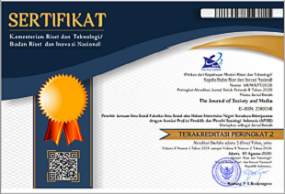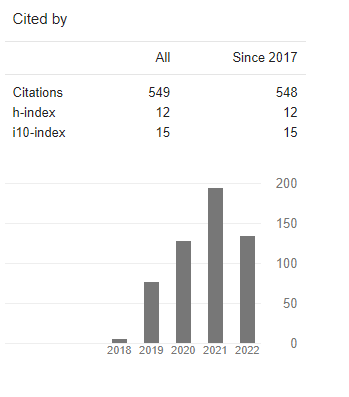Covid-19, Harassment and Social Media: A Study of Gender-Based Violence Facilitated by Technology During the Pandemic
DOI:
https://doi.org/10.26740/jsm.v4n2.p319-347Keywords:
sexual violence, online harassment, gender-based violence, social media, COVID-19Abstract
The transition of all individual activities in the home gives rise to two forms of violence
against women: domestic violence and online sexual violence. Specifically, this article
argues that independent quarantine during the COVID-19 pandemic has shifted the
orientation of community sexual violence to technology-facilitated sexual abuse. Social
media networks have become a trajectory of changes in sexual violence that was initially
physical into online sexual violence. This research uses a qualitative method with a case
study approach to understanding online sexual violence. The data presented here refer to
the experiences of four survivors with different backgrounds and stories. The results show
that technology has facilitated digital abuse, which impacts a series of dangerous
behaviors experienced in social media. As part of social media users, women are very
vulnerable to experiencing online sexual violence from personal relationships,
boyfriends, friends, and relatives. Space and time in the real world folded in such a way
as to provide opportunities for the reality of virtual networks to become a realm of
gender-based violence. At the same time, social media's neutrality then becomes a means
of supporting gender inequality.
References
https://doi.org/10.2139/ssrn.1611818
Cyberbullying Victimization among Egyptian University Students in Beni-
https://doi.org/10.21608/EPX.2018.8948
Backe, Emma Louise, Pamela Lilleston, and Jennifer McCleary-Sills. 2018.
https://doi.org/10.5210/fm.v11i9.1394
Beech, Anthony R., Ian A. Elliott, Astrid Birgden, and Donald Findlater. 2008.
Burke, Sloane C., Michele Wallen, Karen Vail-Smith, and David Knox. 2011.
https://doi.org/10.1016/j.chb.2010.12.010
Connell, R. W. 1995. Masculinities. Berkeley: University of California Press.
Cuklanz, Lisa M. 2000. Rape on Prime Time: Television, Masculinity, and Sexual Violence. Philadelphia: University of Pennsylvania Press.
DeKeseredy, W. S., and M. Corsianos. 2016. Violence against Women in Pornography. New York: Routledge.
Pornography or Something Else Entirely? Police Responses to Non-
Overcome Claims of Civil Immunity by Operators of Revenge Porn
http://www.jstor.org/stable/24758167
Garcia-Moreno, Claudia, Henrica A. F. M. Jansen, Mary Ellsberg, Lori Heise, and
https://doi.org/10.1016/S0140-6736(06)69523-8
Garland, D. 2001. The Culture of Control: Crime and Social Order in Contemporary Society. Oxford: Oxford University Press.
https://doi.org/10.1080/14680777.2019.1706605
https://doi.org/10.1177/0004865814524218
https://doi.org/10.1177/0964663915624273
https://doi.org/10.1016/j.chb.2011.11.001
Jensen, R. 2007. Getting off: Pornography and the End of Masculinity. Cambridge: South End Press.
Sozialwissenschaften.
https://doi.org/10.1177/1362480613504331
https://doi.org/10.1080/0309877X.2019.1688267
Kelly, Liz. 1988. Surviving Sexual Violence. Cambridge: Polity Press.
Litchfield, Chelsea, Emma Kavanagh, Jaquelyn Osborne, and Ian Jones. 2018.
https://doi.org/10.1136/bmj.m1872
Mazza, Marianna, Giuseppe Marano, Carlo Lai, Luigi Janiri, and Gabriele Sani.
https://doi.org/10.1016/j.sbspro.2017.02.009
Noll, Jennie G., Chad E. Shenk, Jaclyn E. Barnes, and Frank W. Putnam. 2009.
Ojanen, Timo T., Pimpawun Boonmongkon, Ronnapoom Samakkeekarom, Nattharat Samoh, Mudjalin Cholratana, Anusorn Payakkakom, and Thomas
https://doi.org/10.1375/acri.43.1.76
https://doi.org/10.1016/j.wsif.2017.10.004
https://doi.org/10.1080/14680777.2020.1749692
Titchen, Kanani E., Sofya Maslyanskaya, Ellen J. Silver, and Susan M. Coupey.
Virilio, Paul. 1986. Speed and Politics: An Essay on Dromology. New York: Semiotext(e).
Virilio, Paul. 1997. Open Sky. London: Verso.
Virilio, Paul. 2000a. Polar Inertia. London: SAGE Publications.
Virilio, Paul. 2000b. The Information Bomb. London: SAGE Publications.
Virilio, Paul. 2008. Negative Horizon. London: Continuum.
Resistance to Online Sexual Harassment Using Humour, Art and
Williams, Matthew. 2006. Virtually Criminal: Crime, Deviance and Regulation Online. New York: Routledge.
Zaleski, Kristen L., Kristin K. Gundersen, Jessica Baes, Ely Estupinian, and
Downloads
Additional Files
Published
How to Cite
Issue
Section
License
Copyright (c) 2020 The Journal of Society and Media

This work is licensed under a Creative Commons Attribution 4.0 International License.
 Abstract views: 9624
,
Abstract views: 9624
, PDF Downloads: 6206
,
PDF Downloads: 6206
, PDF Downloads: 0
PDF Downloads: 0












